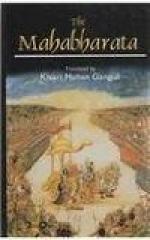160. i.e., the five great elements, four organs of knowledge with mind, and the four organs of action.
161. The word Purusha here is used in the sense of dehabhimani Jiva or individual self with consciousness of body. True knowledge destroys this condition of Jiva, for the man of knowledge identifies himself with the universe and thereby assimilates himself to Brahman. By eaters of Amrita are meant they who never take any food without offering portions thereof to the deities, Pitris, and guests. Of course, Yogins of piety are implied by it.
162. Purusha here implies Jiva divested of consciousness of body.
163. The meaning is this: in a dream what is seen is all unreal. So, when tranquillity has been attained, all the surroundings become unreal. Nilakantha gives a slightly different interpretation; it is this: when tranquillity has been attained, the Soul lives without attachment to the body and all external objects. Indeed, the Soul then lives completely in itself even as it works in course of a dream.
164. The sense is that they behold all worldly objects, present, past and future, which are, of course, due to development of previous causes.
165. This line is rather obscure. The sense seems to be this: no one can know the Supreme Deity if it is not the latter’s pleasure to be known. One, therefore, understands Him in exactly that measure in which it is His pleasure to be known.
166. Krishna’s father Vasudeva is maternal uncle. Yudhishthira asks Krishna to worship Vasudeva and Valadeva on his behalf, i.e., he charges Krishna to bear to them a message of respect and love from him.
167. The city of Hastinapura is sometimes called Nagapura, both Hasti and Naga being words expressive of the elephant. ’The city called after the elephant’ is the usual description of the Kuru capital.
168. Mahyam is equal to ‘mam uddisya’ i.e., referring to my divine nature.
169. An ascetic loses his penances by cursing another rightly or wrongly. Hence, forgiveness was always practised by the Brahmanas who were ascetics. A Brahmana’s strength consisted in forgiveness. The more forgiving he was, the more powerful he became.
170. The first asat or non-existent refers to such objects as the horns of the hare. The second, viz., sadasat, or existent and non-existent refers to such objects as exist and meet with destruction. Sadasat param or that which transcends the existent and non-existent, refers to the unmanifest. The universe consists of these three. All this is from Vasudeva.
171. To this day preceptors in India have to feed and teach their disciples without any pecuniary compensation. In fact, the sale of knowledge has been strictly forbidden. Pupils, however, after completing their studies, had to give the final Dakshina which varied according to their means. The kings and princes of India thought themselves honoured if solicited by pupils in search of the final Dakshina. What Gautama says here is that the object of the final present is to gratify the preceptor. He (Gautama), however, had already been gratified with the dutiful conduct of Utanka. There was no need, therefore, of any present.




